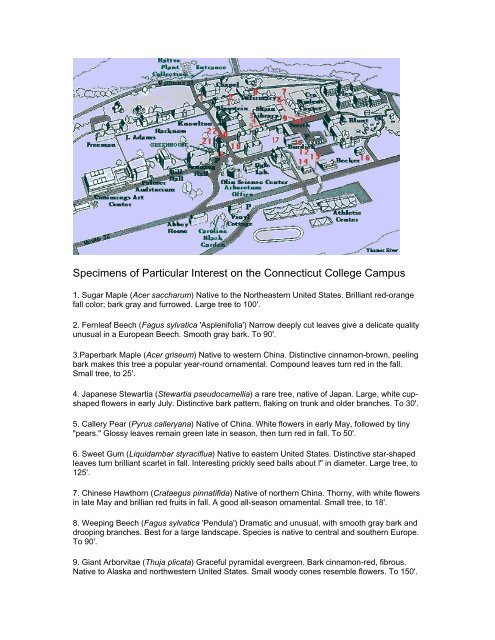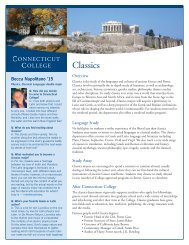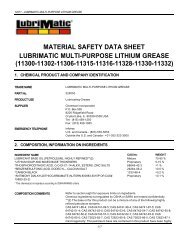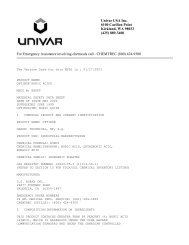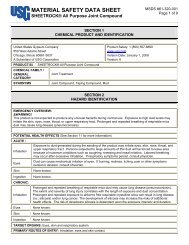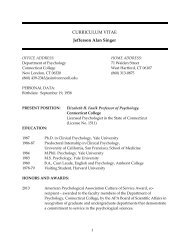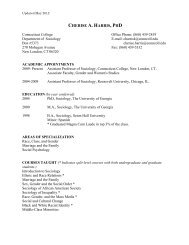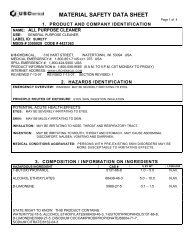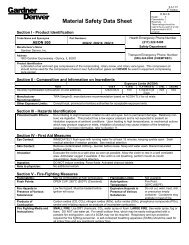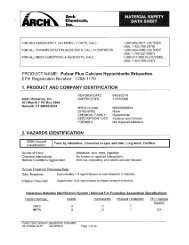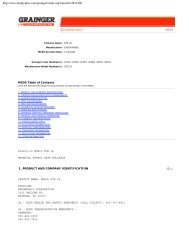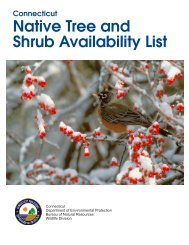Campus map with index - Connecticut College
Campus map with index - Connecticut College
Campus map with index - Connecticut College
You also want an ePaper? Increase the reach of your titles
YUMPU automatically turns print PDFs into web optimized ePapers that Google loves.
Specimens of Particular Interest on the <strong>Connecticut</strong> <strong>College</strong> <strong>Campus</strong>1. Sugar Maple (Acer saccharum) Native to the Northeastern United States. Brilliant red-orangefall color; bark gray and furrowed. Large tree to 100'.2. Fernleaf Beech (Fagus sylvatica 'Asplenifolia') Narrow deeply cut leaves give a delicate qualityunusual in a European Beech. Smooth gray bark. To 90'.3.Paperbark Maple (Acer griseum) Native to western China. Distinctive cinnamon-brown, peelingbark makes this tree a popular year-round ornamental. Compound leaves turn red in the fall.Small tree, to 25'.4. Japanese Stewartia (Stewartia pseudocamellia) a rare tree, native of Japan. Large, white cupshapedflowers in early July. Distinctive bark pattern, flaking on trunk and older branches. To 30'.5. Callery Pear (Pyrus calleryana) Native of China. White flowers in early May, followed by tiny"pears." Glossy leaves remain green late in season, then turn red in fall. To 50'.6. Sweet Gum (Liquidambar styraciflua) Native to eastern United States. Distinctive star-shapedleaves turn brilliant scarlet in fall. Interesting prickly seed balls about l" in diameter. Large tree, to125'.7. Chinese Hawthorn (Crataegus pinnatifida) Native of northern China. Thorny, <strong>with</strong> white flowersin late May and brillian red fruits in fall. A good all-season ornamental. Small tree, to 18'.8. Weeping Beech (Fagus sylvatica 'Pendula') Dramatic and unusual, <strong>with</strong> smooth gray bark anddrooping branches. Best for a large landscape. Species is native to central and southern Europe.To 90'.9. Giant Arborvitae (Thuja plicata) Graceful pyramidal evergreen. Bark cinnamon-red, fibrous.Native to Alaska and northwestern United States. Small woody cones resemble flowers. To 150'.
10. American Arborvitae (Thuja occidentalis) Also called Northern White Cedar. Columnar habit.Foliage evergreen, scale-like and flat. Used as a hedge and ornamental tree. Native to easternNorth America. To 60'.11. Japanese Katsura Tree (Cercidiphyllum japonicum) Leaves heart-shaped, small. Beautifulorange-red fall color. Excellent street tree. Bark shredding. To 60'.12. Nordmann Fir (Abies nordmanniana) Lustrous evergreen needles point up and forward,densely covering branches. Excellent specimen fir, native to Asia Minor. To 200'.13. Red Oak (Quercus rubra) Fast growing, broadheaded tree <strong>with</strong> dull green leaves turningreddish-brown in fall. Spreading branches. Native to eastern North Amenca. To 100'.14. Japanese Umbrella Pine (Sciadopitys verticillata) Not a true pine, but related to the giantredwoods. An excellent and unusual evergreen. Dark foliage whorled around the twigs, denselypyramidal in habit. Native to central Japan. To 120'.15. Yellowwood (Cladrastis lutea) Leaves bright green turning brilliant yellow in fall. Flowers inlarge hanging panicles, white and fragrant. Smooth gray bark. Slow-growing tree <strong>with</strong> domeshapedcrown. To 50'. Native to North Carolina and Tennessee.16. Landscape Demonstration Area for Energy Conservation, and Natural landscaping. The EarthHouse landscape serves as a model by using native plants, reducing the lawn area, and planningfor fruit and shelter for wildlife. Established in 1996.17. Amur Cherry (Prunus maackii) Excellent ornamental <strong>with</strong> cinnamon-brown flaking bark.Racemes of small white flowers are followed by black fruits. Medium size tree. To 40'.18. European Mountain Ash (Sorbus aucuparia) Also called Rowan Tree. Leaves compound.Flowers white, in flat clusters fruit brilliant orange in late summer, effective into fall. Roundheadedtree, 30'-40'.19. Hinoki False Cypress (Chamaecyparis obtusa) Pyramidal evergreen <strong>with</strong> foliage inhorizontally flattened sprays. Excellent ornamental, often confused <strong>with</strong> Arborvitae. Manycultivars in smaller sizes used for specimens in dwarf and rock gardens. To 40'.20. Giant Fir (Abies grandis) Fast growing evergreen <strong>with</strong> pyramidal growth habit. Long needles,dark green above and white banded below. Native to the Pacific Northwest. To 100'.21. Japanese Pagoda Tree (Sophora japonica) Compound leaves similar to honey locust. Largepanicles of pale yellow pea-like blossoms in August followed by green pods. Fall color is a clearyellow. Dense upright growth when young, becoming round and spreading <strong>with</strong> age. Slowgrowing tree, to 50'.22 . Japanese Larch, (Larix kaempferi) Deciduous coniferous tree <strong>with</strong> spreading pyramidal habit.Needles soft, light green in "tufts" turning light bronze in fall before dropping. Fast growing, 80'.Native to Japan.


